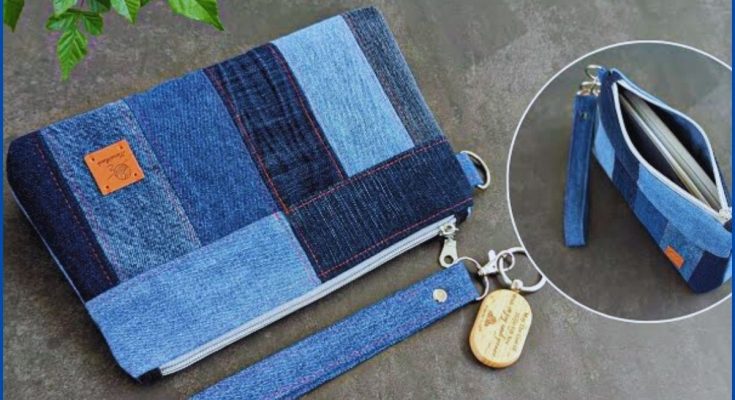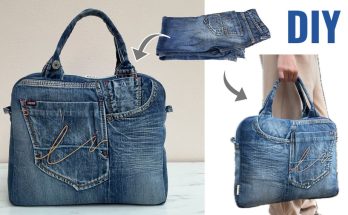It’s fantastic you’re looking to create a zippered handbag from your leftover denim fabric! This is a super smart way to use up scraps from previous projects and turn them into a practical and stylish accessory. Denim is wonderfully durable, making it ideal for a handbag, and a zipper closure adds excellent security.
This detailed guide will walk you through making a versatile small-to-medium-sized handbag with a flat bottom, a secure top zipper, an interior pocket, and a comfortable strap, all from your upcycled denim.
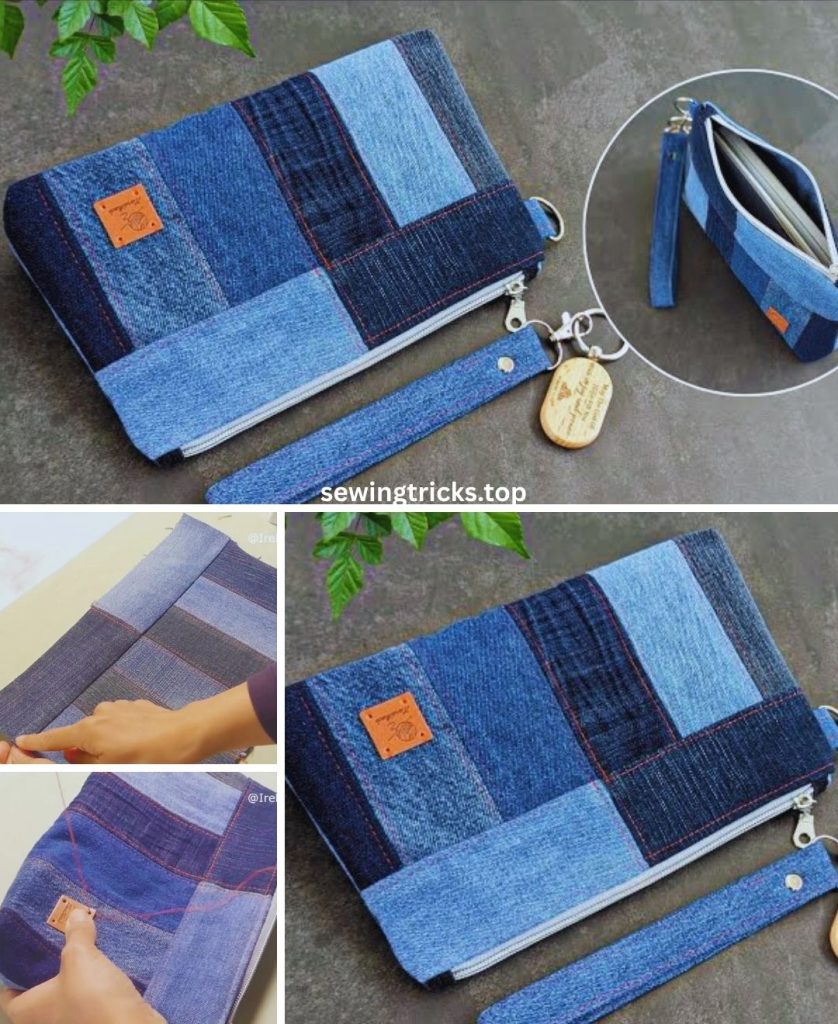
How to Sew a DIY Handbag with a Zipper from Old Jeans Leftover Fabric
I. Planning Your Upcycled Denim Handbag
Careful planning is crucial when working with fabric scraps. It helps you assess what you have and design a bag that maximizes your leftover denim.
- Assess Your Fabric Leftovers:
- Lay out all your denim scraps. Can you get two large enough rectangles for the main body of the bag? Or will you need to piece several smaller scraps together? Don’t be afraid to embrace a “patchwork” look if that’s what your scraps allow – it can add unique character!
- Do you have enough for the strap? If not, you might need to use webbing or a complementary fabric.
- Desired Handbag Size: Think about what you typically carry in a handbag.
- A good versatile size might be around 10 inches wide x 8 inches tall x 3 inches deep (25.4 cm x 20.3 cm x 7.6 cm) when finished. This fits essentials like a wallet, phone, keys, and a few small items.
- Denim Features to Reuse (Optional):
- Original Seams/Topstitching: Strategically place these on your bag panels for a ready-made decorative touch.
- Small Pockets: A small back pocket from the jeans could be appliquéd onto the exterior or interior for a quick extra pocket.
- Lining: Highly recommended! A lining gives your bag a professional finish, hides raw seams, and adds durability. You’ll likely use new fabric for this, or coordinating fabric scraps.
- Stabilizer/Interfacing:Essential! This gives your handbag structure and prevents it from being floppy.
- Heavyweight Fusible Interfacing (e.g., Pellon 809 Decor Bond or Pellon 71F Peltex II Ultra Firm): Ideal for a structured bag.
- Zipper: The main closure for security.
II. Gather Your Materials
Having all your supplies ready before you start sewing will make your project much smoother and more enjoyable.
- Old Jeans Leftover Fabric: Enough clean, ironed, sturdy denim scraps to cut your pieces.
- Lining Fabric: 1/2 to 3/4 yard (0.45 to 0.68 meters) of medium-weight quilting cotton, broadcloth, or poly-cotton. Pick a fun print or color that complements your denim.
- Zipper: 1 zipper, 11-12 inches (28-30.5 cm) long. A standard coil zipper is easiest for beginners. Choose a color that matches or contrasts nicely.
- Heavyweight Fusible Interfacing: 1/2 to 3/4 yard (0.45 to 0.68 meters) (e.g., Pellon 809 Decor Bond or Pellon 71F Peltex II Ultra Firm).
- Matching Thread: Strong, all-purpose polyester thread. For topstitching on denim, use a slightly thicker topstitching thread in a contrasting color (like gold, orange, or beige).
- Optional Hardware for Strap: Two D-rings or Rectangle Rings (1-inch/2.5 cm or 1.5-inch/3.8 cm, to match your strap width) and two swivel clasp hooks if you want a removable strap.
- Basic Sewing Supplies:
- Sewing Machine: With a zipper foot (essential for sewing close to the zipper teeth) and ideally a walking foot (helpful for thick denim layers).
- Heavy-Duty Needles: Denim needles (size 90/14 or 100/16) are essential. Keep spares.
- Sharp Fabric Scissors or Rotary Cutter and Mat.
- Long Quilting Ruler or Measuring Tape.
- Fabric Chalk or Mark-B-Gone Pen.
- Plenty of Pins or Fabric Clips (excellent for holding thick layers and zippers).
- Iron and Ironing Board (crucial for pressing seams flat and fusing interfacing).
- Seam Ripper (your best friend for deconstructing jeans and correcting mistakes!).

III. Prepare & Cut Your Fabric Pieces
Accuracy in cutting leads to a well-fitting, professional-looking bag. We’ll use a consistent 1/2-inch (1.27 cm) seam allowance throughout this tutorial.
- Desired Finished Handbag Size: 10″ W x 8″ H x 3″ D (25.4 cm x 20.3 cm x 7.6 cm).
A. Cut Your Fabric Pieces:
- Exterior Denim Pieces:
- Main Body (Front & Back): Cut 2 rectangles, each 14 inches wide x 12 inches high. (This accounts for 10″ finished width + 3″ finished depth + 1″ seam allowance on sides. Same for height: 8″ H + 3″ D + 1″ SA = 12″ H).
- Important Note on Piecing: If your leftover denim isn’t large enough for these rectangles, you will need to piece together smaller scraps. To do this, place two denim pieces right sides together, stitch along one edge with a 1/2-inch seam, press the seam open, and then topstitch on both sides of the seam for strength and a decorative finish (like real jean seams). Continue piecing until you have two panels large enough for your final cut.
- Strap (Option 1: Fabric Strap): Cut 1 rectangle, 4 inches wide x 45-50 inches long (adjust length as desired for shoulder or cross-body wear). You will likely need to piece this from several denim scraps.
- Strap Tabs (Option 2: For Hardware): If using D-rings/rectangle rings, cut 2 rectangles, each 3 inches wide x 4 inches high.
- Main Body (Front & Back): Cut 2 rectangles, each 14 inches wide x 12 inches high. (This accounts for 10″ finished width + 3″ finished depth + 1″ seam allowance on sides. Same for height: 8″ H + 3″ D + 1″ SA = 12″ H).
- Lining Fabric Pieces:
- Main Body (Front & Back): Cut 2 rectangles, each 14 inches wide x 12 inches high.
- Interior Slip Pocket (Optional): Cut 1 rectangle, 8 inches wide x 10 inches high.
- Heavyweight Fusible Interfacing:
- Main Body Panels: Cut 2 rectangles, each 13 inches wide x 11 inches high (1 inch smaller on all sides than your main fabric panels to keep bulk out of the seam allowances).
- Strap (Option 1): Cut 1 rectangle, 3 inches wide x (Strap Length – 1 inch).
- Strap Tabs (Option 2): Cut 2 rectangles, 2 inches wide x 3 inches high.
IV. Let’s Start Sewing Your Denim Handbag!
General Sewing Tips for Denim & Zippers:
- Press, Press, Press: This is the most crucial step for a crisp, professional-looking bag. Press seams after each stitching step.
- Backstitch: Always backstitch at the beginning and end of each seam to secure your stitches.
- Use your zipper foot: You’ll need this to get nice, close stitches to the zipper teeth.
- Use clips: They are excellent for holding thick denim layers and zippers in place, much better than pins.
- Go slow: Take your time, especially when sewing around corners or over thick spots. Precision over speed!
- Topstitching: Use a slightly longer stitch length (3.0-3.5mm) for topstitching for a more professional, intentional look.
Step 1: Fuse Interfacing to Exterior Panels & Strap Pieces
- Take your two Exterior Denim Main Body Panels and your denim strap piece(s). Lay each one wrong side up on your ironing board.
- Center the corresponding Interfacing piece on each fabric panel/strap (it should be 1 inch smaller on all sides).
- Following the manufacturer’s instructions for your specific interfacing, fuse the interfacing to the wrong side of the fabric. Press firmly and allow to cool completely. This gives your bag and strap structure.
Step 2: Prepare Interior Slip Pocket (Optional)
- Take your 8″ x 10″ pocket piece (lining fabric).
- Fold one long 8-inch edge down by 1/2 inch (1.27 cm) towards the wrong side and press. Fold it down again by another 1/2 inch and press. Stitch this hem in place, close to the folded edge. This is the top edge of your pocket.
- Fold the other three raw edges (the two short 10-inch sides and the bottom 8-inch side) in by 1/2 inch and press.
- Position this prepared pocket onto the right side of one of your Lining Fabric Main Body Panels. Center it horizontally, about 2-3 inches (5-7.6 cm) down from the top raw edge.
- Topstitch the pocket in place along its two sides and bottom edge, close to the folded edges. Backstitch at the beginning and end, and reinforce the top corners with a small triangle stitch or extra back-and-forth stitches for durability.
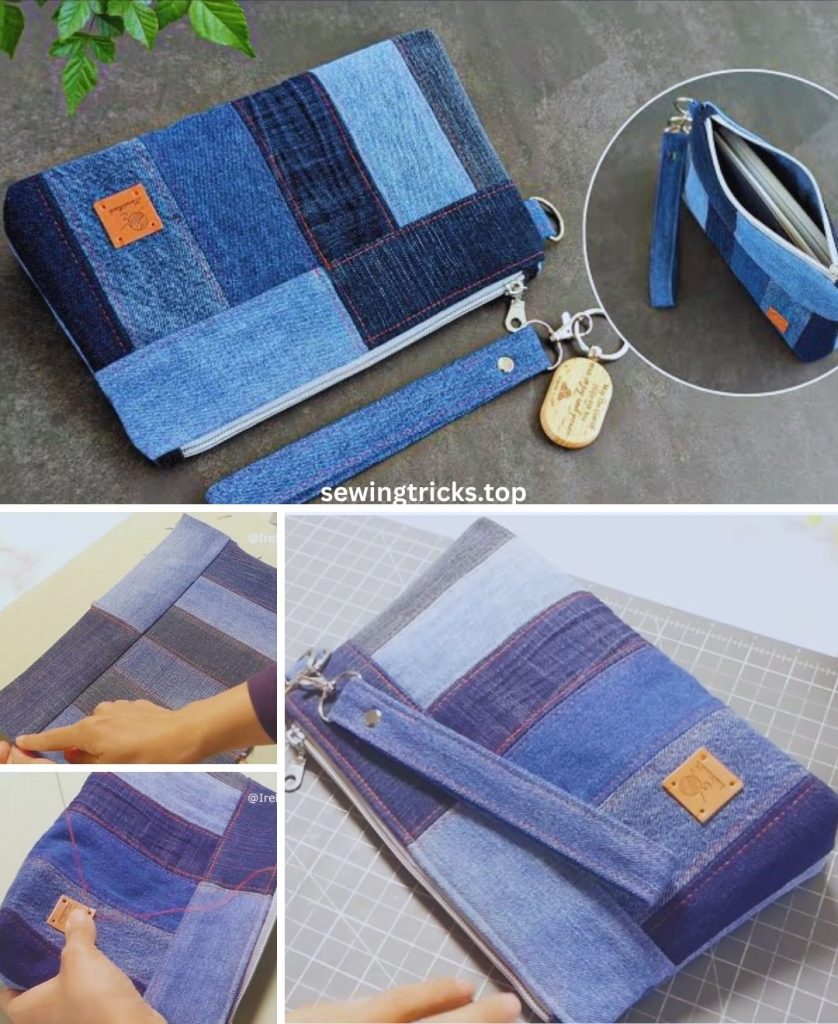
Step 3: Attach the Zipper
This is often the trickiest part for beginners, but take it slow for a clean result!
- Lay one Exterior Denim Main Body Panel right side up.
- Place your zipper on top of the denim panel, right side down, aligning the top edge of the zipper tape with the top raw edge of the denim panel. The zipper teeth should be facing down.
- Place one Lining Fabric Main Body Panel on top of the zipper, right side down, aligning its top raw edge with the zipper tape and the denim panel.
- You now have a “sandwich”: Denim (right side up) – Zipper (right side down) – Lining (right side down).
- Clip all three layers together along the top edge.
- Using your zipper foot, stitch through all three layers, sewing as close to the zipper teeth as possible. Stitch from one end of the zipper to the other.
- Press: Open up the fabric pieces so the denim and lining are pulled away from the zipper, and the zipper teeth are exposed. Press the fabric well away from the zipper.
- Topstitch: On the right side of the denim, sew a line of topstitching very close to the seam you just made (about 1/8 inch / 0.3 cm from the zipper teeth). This helps the fabric lay flat and gives a polished look.
- Now, you’ll attach the other side of the zipper.
- Take your remaining Exterior Denim Main Body Panel. Lay it right side up.
- Take the already-attached zipper/denim/lining unit. Place it on top of the new denim panel, aligning the unstitched side of the zipper tape with the top raw edge of this new denim panel. The first denim piece and lining should be flipped out of the way.
- Place the remaining Lining Fabric Main Body Panel on top of the zipper tape, right side down, aligning its top raw edge with the zipper tape and the denim.
- You now have a second “sandwich”: New Denim (right side up) – Zipper (unstitched side down) – New Lining (right side down).
- Clip all three layers together.
- Using your zipper foot, stitch through all three layers, as close to the zipper teeth as possible.
- Press & Topstitch: Open up the fabric pieces and press well away from the zipper. Then, topstitch on the right side of the denim, close to the zipper teeth.
- Result: You now have a flat piece of fabric with the zipper running across the middle, and the denim pieces on the outside, lining pieces on the inside.
Step 4: Prepare the Handbag Strap
A. Fabric Strap (No Hardware):
- Take your 4″ x (desired length) denim strap piece.
- Fold it in half lengthwise, wrong sides together, and press firmly. Open it up.
- Fold each long raw edge in towards the center crease you just made, and press again.
- Fold the entire strip in half again along the original center crease. You should now have a long, flat strap that is about 1 inch (2.5 cm) wide with no raw edges visible. Press firmly along the entire length.
- Topstitch down both long sides of the prepared strap, about 1/8 inch (0.3 cm) from the edge. This secures all the folds and makes a neat, strong strap. Set aside.
B. Strap with Hardware (D-rings/Swivel Clasps):
This option makes your strap removable.
- Take your 4″ x (desired length) denim strap piece. Prepare it exactly as described in A.1 to A.4 above, but do not topstitch yet.
- At each end of the strap, thread a swivel clasp hook onto the strap.
- Fold the end of the strap back by about 1.5 inches (3.8 cm) to enclose the metal bar of the swivel clasp. Stitch this fold down securely with a square or X-box stitch. Repeat for the other end.
- Now, topstitch down both long sides of the prepared strap from end to end, about 1/8 inch (0.3 cm) from the edge.
- Prepare the Strap Tabs (2 pieces, 3″ x 4″ denim): Fold each tab in half lengthwise, wrong sides together, press. Fold long raw edges to center, press. Fold in half again. Topstitch along both long sides.
- Thread a D-ring or rectangle ring onto each tab. Fold the tab in half to create a loop, enclosing the D-ring.
- Attach Strap Tabs to Exterior Bag:
- Find the center of each side of the exterior denim bag (perpendicular to the zipper).
- Position the raw ends of one strap tab at the top edge of the bag, centered on the side seam. The D-ring should face inward. The raw ends should align with the top raw edge of the bag (which is where the zipper tape is sewn).
- Stitch in place within the 1/2-inch seam allowance. Repeat for the other side.
Step 5: Sew the Bag Body (Exterior and Lining)
CRITICAL STEP: UNZIP THE ZIPPER HALFWAY OR MORE BEFORE SEWING! If you forget this, you won’t be able to turn your bag right side out.
- Pull the exterior denim pieces together so they are right sides together. Align the unstitched raw edges, forming a “tube.” Clip or pin along the bottom and side seams. If using strap tabs, make sure they are tucked inside and not caught in the seam.
- Pull the lining fabric pieces together so they are also right sides together. Align the unstitched raw edges, forming a “tube.” Clip or pin along the bottom and side seams.
- For the Lining: Along the bottom seam of the lining, leave a 3-4 inch (7.6-10.2 cm) opening in the middle. This is essential for turning the bag right side out later. Backstitch well at the start and end of this opening.
- Stitch all the way around the exterior denim “tube” (bottom and two sides) using a 1/2-inch seam allowance.
- Stitch all the way around the lining “tube” (bottom – remembering the opening! – and two sides) using a 1/2-inch seam allowance.
- Press all seams open. This reduces bulk and gives a cleaner finish.
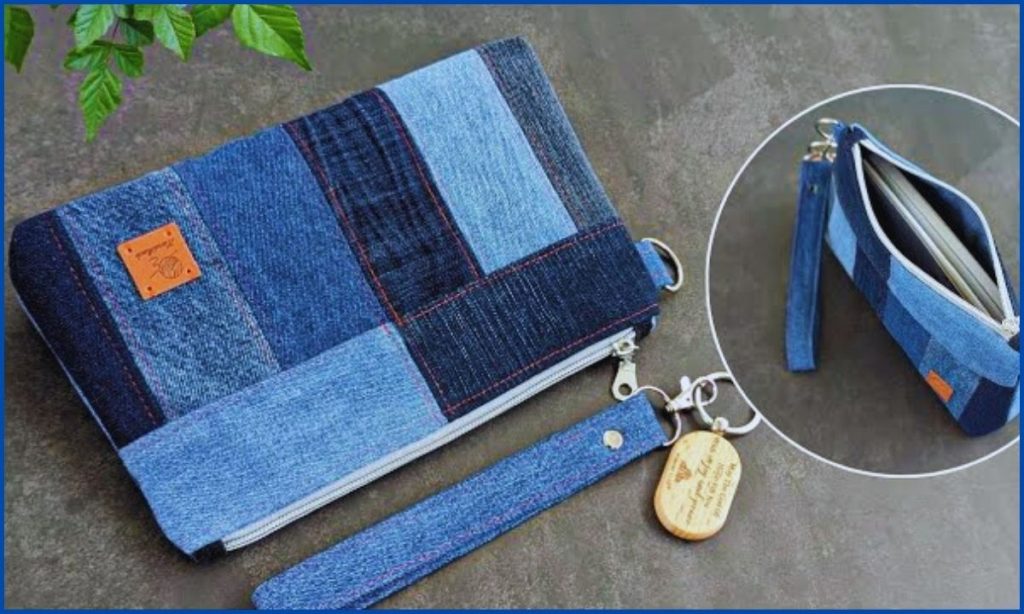
Step 6: Box the Corners (Exterior and Lining)
This step creates the flat, defined bottom of your handbag.
- At one of the bottom corners of the exterior denim bag, carefully bring the side seam and the bottom seam together, aligning them perfectly. This will naturally form a triangular shape at the corner.
- Measure from the tip of this triangle inward along the seam line a distance equal to half of your desired bag depth (e.g., for a 3-inch deep bag, you’ll measure 1.5 inches / 3.8 cm).
- Draw a straight line perpendicular to the seam at this measured point. This is your new stitching line. (For a 3-inch deep bag, this line will be 3 inches long).
- Clip firmly along this drawn line.
- Stitch precisely along the drawn line, backstitching securely at both ends.
- Trim the excess fabric from the corner, leaving about a 1/2-inch (1.27 cm) seam allowance beyond your new stitching line.
- Repeat this exact process for all three remaining corners (the other exterior corner and both lining corners).
- Result: Both your exterior denim bag and your lining bag now have structured, flat bottoms.
Step 7: Final Assembly (The “Bag-in-a-Bag” Method)
- Keep the exterior denim bag wrong side out.
- Turn the lining bag right side out.
- Carefully insert the exterior denim baginto the lining bag.
- The wrong side of the exterior bag should now be facing the right side of the lining.
- The zipper tape should be between the two layers.
- Align all the seams (side seams and corner seams) and the top edges of the zipper tape.
- Clip very securely all the way around the zipper opening.
- You might notice the lining is a bit bigger than the exterior at the top. This is good! It helps the lining sit nicely inside.
Step 8: Turn Your Bag Right Side Out & Finish
This is the incredibly satisfying moment your upcycled denim handbag takes its final, beautiful shape!
- Remember that opening you left in the bottom seam of the lining (Step 5)? Reach through it.
- Slowly and carefully pull the entire bag (exterior, zipper, lining – everything!) through this opening until it is completely right side out. Take your time, gently pushing out all the corners for a crisp, well-defined shape.
- Close the Lining Opening: Go to your ironing board. Press the raw edges of the opening in the bottom of the lining under by 1/2 inch (1.27 cm) so they meet neatly. Align these pressed edges and clip them together. Stitch this opening closed by machine (sewing very close to the folded edge for a neat finish) or by hand using an invisible ladder stitch for a truly seamless look.
- Now, gently push the lining down into the exterior denim bag.
- Final Press: Carefully press the entire bag, especially around the zipper, to ensure the fabric lays flat and the shape is crisp.
- Attach Strap: If you made a simple fabric strap (Option 4A), you can stitch the ends securely to the top side seams of the bag, just below the zipper, using an X-box stitch. If you opted for the removable strap (Option 4B), simply clip your swivel hooks to the D-rings you attached.
Your unique, upcycled Denim Handbag with Zipper is now complete! You’ve transformed leftover denim scraps into a functional, durable, and truly stylish accessory that’s one-of-a-kind. Enjoy carrying your sustainable creation with pride!
What kind of unique details did you incorporate from your old jeans into your new handbag?

